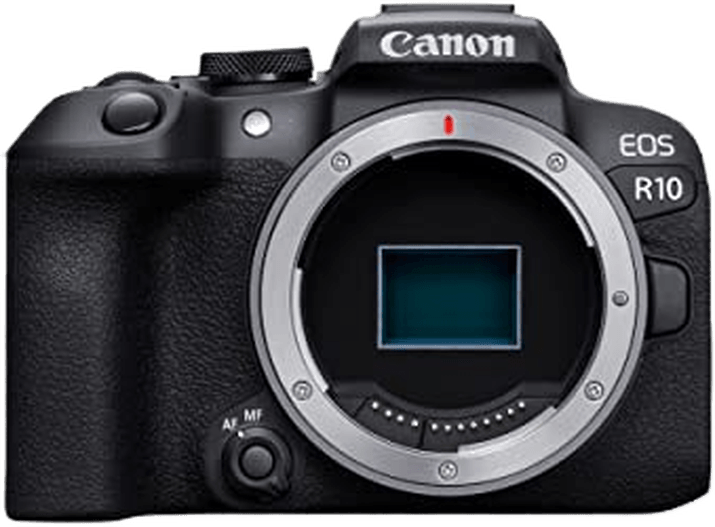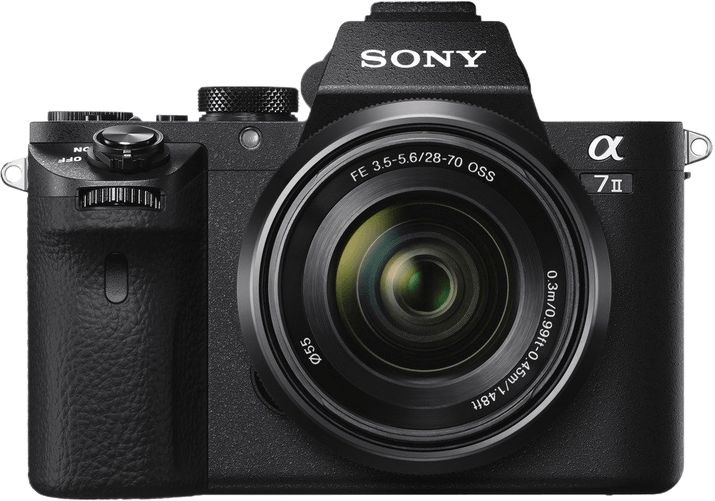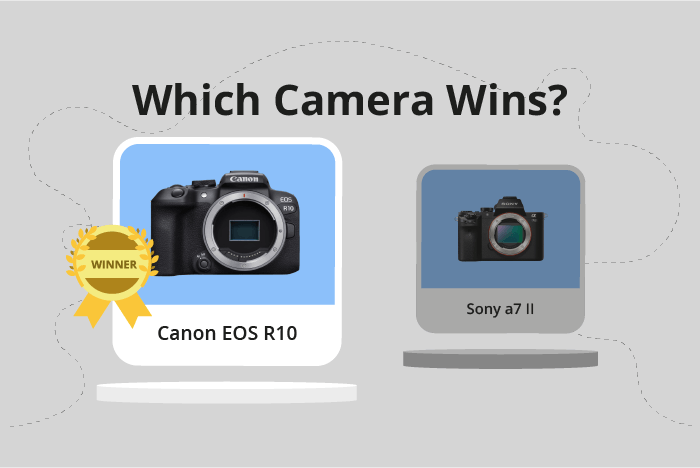Canon EOS R10 vs Sony a7 II Comparison
Canon EOS R10

Sony a7 II

The Canon EOS R10 and Sony a7 II are close competitors. Both cameras are mirrorless and share some common features. However, the EOS R10, released in 2022, is newer and has a more affordable launch price of $980, while the a7 II was released in 2014 with a launch price of $1600.
The Canon EOS R10 stands out with its compact size, measuring 123 x 88 x 83mm, and lighter weight of 426g (0.94lbs). On the other hand, the Sony a7 II is slightly larger at 127 x 96 x 60mm and heavier, weighing 599g (1.32lbs).
Despite the Sony a7 II’s higher launch price and older release date, its score remains competitive with the EOS R10. This suggests that the a7 II may still offer valuable features and performance for certain users.
Taking into account the scores, size, weight, and launch prices, the Canon EOS R10 offers a more affordable and portable option, while the Sony a7 II remains a viable choice for those who prioritize specific features or have brand loyalty.
Canon EOS R10 vs Sony a7 II Overview and Optics
The Sony a7 II triumphs over the Canon EOS R10 in the optics category with a score of 78/100, compared to the R10’s 71/100. Both cameras share certain specifications, such as 24-megapixel CMOS sensors and lens mounts specific to their respective brands. However, there are key differences that contribute to the higher score for the Sony a7 II.
The Sony a7 II boasts a full-frame sensor, while the Canon EOS R10 has an APS-C sensor. This gives the a7 II a clear advantage in image quality, as full-frame sensors typically capture more detail and perform better in low light. Additionally, the Sony a7 II features image stabilization, which helps to reduce camera shake and produce sharper images. This is an important factor in the optics comparison, as the Canon EOS R10 lacks this feature.
On the other hand, the Canon EOS R10 has a faster shooting speed of 15 frames per second, compared to the Sony a7 II’s 5 frames per second. This makes the R10 better suited for capturing fast-moving subjects. Furthermore, the R10’s Digic X processor outperforms the Sony a7 II’s Bionz X processor, as evidenced by the higher DXOMARK score of 97 for the R10’s sensor.
Despite these advantages for the Canon EOS R10, the Sony a7 II’s full-frame sensor and image stabilization ultimately give it the edge in the optics category. The R10’s faster shooting speed and superior processor are not enough to overcome the significant benefits offered by the a7 II’s full-frame sensor and image stabilization. Therefore, the Sony a7 II is the better choice for those prioritizing optics quality.
Canon EOS R10 vs Sony a7 II Video Performance
The Canon EOS R10 outperforms the Sony a7 II in video capabilities with a score of 91/100 compared to the Sony’s 56/100. Both cameras share some common specifications, but the Canon EOS R10 surpasses the Sony a7 II in several key areas.
One significant advantage of the Canon EOS R10 is its maximum video resolution of 4K, with dimensions of 3840 x 2160, while the Sony a7 II only offers Full HD resolution at 1920 x 1080. This difference in resolution means the Canon EOS R10 captures much more detail and provides a higher quality video output. Furthermore, the Canon EOS R10 boasts a maximum video frame rate of 120fps, double that of the Sony a7 II’s 60fps. This higher frame rate allows for smoother motion capture and improved slow-motion capabilities.
Another notable feature of the Canon EOS R10 is its built-in time-lapse functionality, which the Sony a7 II lacks. This feature enables users to create stunning time-lapse videos without the need for additional equipment or software.
While the Sony a7 II falls short in these areas, it is still a capable camera for video recording. Its Full HD resolution and 60fps frame rate are suitable for casual video recording and provide satisfactory results for most users. However, for those seeking higher quality video and more advanced features, the Canon EOS R10 is the clear winner.
Considering the significant difference in video scores, the Canon EOS R10 proves to be a superior choice for videographers and content creators, offering higher resolution, faster frame rates, and built-in time-lapse capabilities. Meanwhile, the Sony a7 II may be a suitable option for those with less demanding video requirements but still want a reliable camera for recording.
Canon EOS R10 vs Sony a7 II Features and Benefits
The Canon EOS R10 outperforms the Sony a7 II in features, scoring 70 out of 100 points compared to the Sony a7 II’s 57 points. Both cameras share some common specifications, such as a 3-inch screen size, flip screen, lack of GPS, and WIFI connectivity. However, there are key differences that set them apart.
The Canon EOS R10 has a touchscreen, which the Sony a7 II lacks. This makes the EOS R10 more user-friendly, as it allows for easier navigation and control. Additionally, the EOS R10 features Bluetooth connectivity, providing more options for wireless communication and remote control.
On the other hand, the Sony a7 II has a higher screen resolution at 1,230,000 dots compared to the EOS R10’s 1,040,000 dots. This results in a sharper and more detailed display on the Sony a7 II, which can be beneficial for previewing images and videos.
Despite the higher screen resolution of the Sony a7 II, the Canon EOS R10 still comes out ahead due to its touchscreen and Bluetooth capabilities. The added convenience and functionality provided by these features make the EOS R10 a more versatile and user-friendly option.
As for the Sony a7 II, its higher screen resolution is a notable advantage, but it falls short in other areas, such as lacking a touchscreen and Bluetooth connectivity. Although it is a solid camera, the Canon EOS R10 offers more features and a better overall experience for users.
Canon EOS R10 vs Sony a7 II Storage and Battery
The Canon EOS R10 outperforms the Sony a7 II in storage and battery with a score of 40/100 compared to 35/100. Both cameras have one memory card slot and accept SD/SDHC/SDXC cards. However, the Sony a7 II also accommodates Memory Stick Duo/Pro Duo/Pro-HG Duo cards.
The Canon EOS R10 has a superior battery life, providing 450 shots per charge, while the Sony a7 II offers 350 shots. The Canon uses an LP-E17 battery, and the Sony uses an NP-FW50 battery.
The Sony a7 II’s advantage is its compatibility with Memory Stick cards, offering flexibility in storage options. However, the Canon EOS R10’s longer battery life and USB charging capability make it the better choice for extended shooting sessions and convenient charging options.
Canon EOS R10 vs Sony a7 II – Our Verdict
Are you still undecided about which camera is right for you? Have a look at these popular comparisons that feature the Canon EOS R10 or the Sony a7 II:

